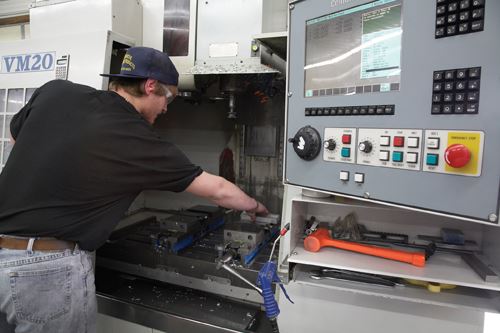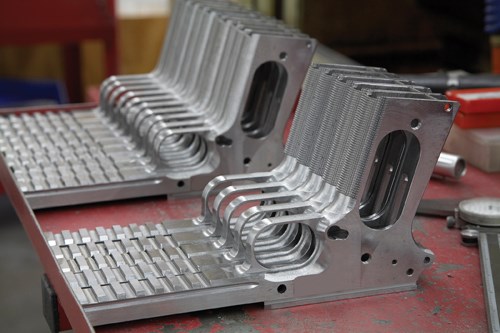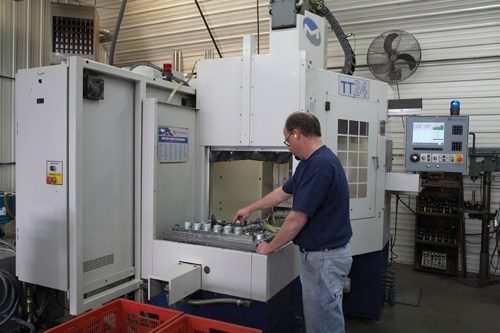At Innovative Machine, producing parts requires focusing on form as well as function. Here, machinists also consider themselves artists—and for good reason. Many of the firearm component manufacturer’s customers view their firearms not just as functional tools, but as fashion statements. Maintaining a reputation for trendy, aesthetic designs demands the ability to accommodate a variety of custom work, often on short notice.
To attain the flexibility required for this custom work, the shop has adopted a production process that is as uniform as possible. To that end, approximately 75 percent of parts are processed on equipment from a single builder: Milltronics CNC Machines (Waconia, Minnesota). Standardizing on a single brand of machines that use a common control system and interface has simplified job scheduling, programming and maintenance, says Kim McCubbin, owner and president of Innovative Machine. As a result, the shop can keep pace with urgent demands for parts while continuing to provide customers with creative help.
Mr. McCubbin founded Innovative Machine in 1993 with a $5,000 investment in his first CNC machine. “It was a manual tool-change machine,” he says. “It was slow, but it ran good tolerances, and that did the job,” he recalls. Today, the Geneseo, Illinois-based shop houses 24 CNC machines, 14 of which are from Milltronics. To run the machines, a team of 12 operators rely on their machining skills and creativity alike. With the exception of receivers, the shop has produced nearly every firearm component, including checkering pistol grips, gas blocks, sights, flash suppressors, hand guards and more. Most are made of aluminum, and tolerances for the most demanding parts can approach 0.0005 inch.
For that sort of work, Mr. McCubbin says he appreciates the Milltronics VMCs’ thermal compensation systems and heavily ribbed castings. Likewise, features such as fourth-axis rotary tables, relatively long travels and high-pressure coolant provide the flexibility required for complex parts such as rifle hand guards, which require various holes and dovetails around their ODs.
Such mechanical attributes explain much of the reason why the shop repeatedly turns to the same builder for new equipment. However, Mr. McCubbin emphasizes that the benefits of standardizing on one brand extend beyond any single job or machine. With a common CNC and conversational programming interface, all the VMCs are equally capable of processing any given part program. Likewise, any operator trained on the system can program any machine on the shop floor.
The flexibility this provides often manifests itself even before machining begins, Mr. McCubbin says. Consider the planning process for a repeat job. With a program already prepared, the shop is relatively unrestricted in terms of which machine it can choose to process the part. Even if the part calls for a machine with certain attributes, such as one of the models with a fourth-axis rotary table, the shop usually has a number of options. In contrast, a shop with a more varied mix of equipment might have to wait until a specific machine is open, translate the program into a format the CNC can interpret, or start a new program from scratch.
Although a CAM system with the right postprocessors could provide similar benefits, programming conversationally on the shop floor is a better option for Innovative Machine, Mr. McCubbin says. Among other reasons, the shop’s work requires mostly simple 2D programming, not to mention special-geometry cutting tools that would be more time-consuming to render in a CAM program.
It also helps that an intuitive programming interface is one of the Milltronics machines’ stand-out features, he says. This makes programming fast and easy. Also, new hires can typically learn the system quickly and go on to operate any Milltronics machine in the shop. However, Mr. McCubbin emphasizes that this ease of use does not come at the expense of functionality. The menu-driven interface provides access to advanced functions when needed without unnecessary clutter. “I’ve walked up to some controls that look like the cockpit of a space shuttle,” he says. “This one offers a ton of features, but it’s not overwhelming either.”
The user-friendly controls are particularly beneficial when time is short. That’s a common scenario at Innovative Machine, especially as the shop readies new products for the National Shooting Sports Foundation’s annual SHOT Show. Customers typically want to introduce better, more attractive guns to outdo those of their competitors, and the shop prides itself on recommending ideas about how to make components more cosmetically appealing. The problem is, some customers come up with ideas only weeks before the show.
In such cases, one time-saving strategy often employed at Innovative Machine is combining portions of existing programs to create a new program. While designs can vary widely from part to part, they are often similar enough that this cut-and-paste method is easier than starting from scratch. Many designs even originate this way, as customers often get ideas from a range of different firearm components and ask the shop to combine certain features. The ability to merge programs and parts of programs in this way dovetails with the time-saving features of the control, Mr. McCubbin says. “The standardization of programming is priceless,” he says. “We can make a program once, and it’s good to go for almost any machine we have.”
Finally, standardizing on a single machine brand also simplifies maintenance. For example, if Mr. McCubbin suspects a problem with a particular machine component, he can swap it with the same component from another machine to test that theory. Likewise, components tend to wear at the same rate from machine to machine. As a result, the shop can make relatively accurate predictions about what will need attention and when. Maintaining inventories of these components saves time even beyond Milltronics’ policy of next-day delivery, he says. He adds that the control system’s “excellent” self-diag-nostic functions often reduce or eliminate troubleshooting.
Innovative Machine’s future business expectations are promising, Mr. McCubbin says. In fact, by the time this article goes to press, the shop will have taken delivery of six new machines to accommodate increased demand. All are VMCs from Milltronics with extended axis travels and fourth-axis rotary tables. “I don’t see any benefit of buying another brand unless it’s unique in what it does,” he says. “Milltronics machines have always made money for me, so I stick with them.”









.png;maxWidth=300;quality=90)





.png;maxWidth=300;quality=90)















